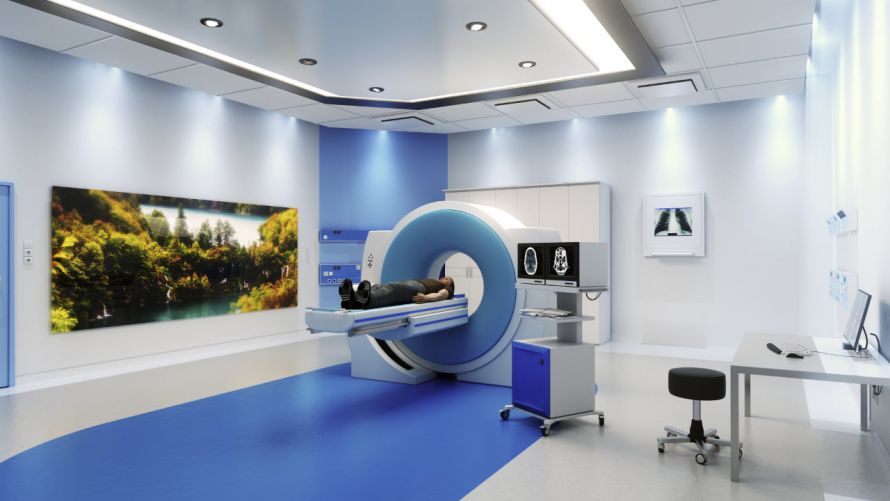Brief overview:
- What is MRgFUS? A modern therapeutic ultrasound procedure for the gentle treatment of diseases.
- Diseases treated: Uterine myomas, adenomyosis, bone tumors, early stage prostate cancer, facet joint osteoarthritis, tremor in Parkinson's disease.
- Principle of action: Focused ultrasound beams precisely heat diseased tissue to up to 80 °C and destroy it directly within the body.
- Advantages: No surgical wounds, no harmful radiation, gentle on surrounding tissue, no hormone administration, organ preserving, no interference with the function of affected organs, low pain.
- Aftercare: Long periods of recovery are not necessary. A follow-up examination may be necessary after a few months to check the results.
- Risks: Complications rarely occur. These include: Redness and skin burns, dizziness, nausea, vomiting, anxiety, nerve irritation, inflammation, vaginal discharge, bowel injuries.
Recommended specialists
Article overview
MRgFUS - Further information
The term MRgFUS is an abbreviation for a modern non-invasive therapeutic procedure and stands for magnetic resonance imaging-guided highly focused ultrasound wave therapy.
Focused ultrasound waves are precisely directed into the therapy area and destroy the diseased tissue with a local heat development of up to 80 degrees Celsius - in medicine this is referred to as thermoablation.
The treatment is carried with constant control and monitoring of the focused ultrasound waves by means of magnetic resonance imaging (MRI, also known as nuclear spin tomography). This ensures that only pathological tissue is heated and surrounding healthy tissue (e.g. muscles, blood vessels and nerves) is spared. MRgFUS can replace surgery or other forms of therapy in certain situations.
Reasons for treatment
Therapy with magnetic resonance imaging-guided focused ultrasound waves is a safe and gentle, low-pain, non-invasive procedure that does not require surgery and thus no skin incisions. Therefore, it is also suitable for patients who refuse a surgical procedure under anesthesia or for whom surgery might be too risky.
Most treatments are performed under analgesia, i.e. potential pain during therapy is well controlled by painkillers. However, if pain does occur, the patient has the option to provide feedback and interrupt the heat ablation at any time.
This makes the treatment very safe. For patients with prostate cancer or a bone tumor, general anesthesia is necessary so that the doctor can work with precision.
Which diseases can be treated with MRgFUS?
Diseases that can be treated with MRgFUS include:
- Myomas in the uterus (uterine myoma)
- Adenomyosis (adenomyosis uteri)
- Benign bone tumors (osteoid osteomas)
- Malignant bone tumors (painful bone metastases)
- Benign soft tissue tumors (desmoid tumors)
- Early stage prostate cancer
- Osteoarthritis of the intervertebral joints (facet joint osteoarthritis)
- Essential tremor or tremor in Parkinson's disease
What can MRgFUS achieve?
MRgFUS treatment aims to completely destroy a tumor or to reduce severely debilitating symptoms (e.g., back pain, increased menstrual bleeding, tremor in Parkinson's disease). Healthy, functionally important tissue is being preserved in the process.
MRgFUS for myomas
Uterine myomas are benign tumors of the uterus that are common in women and cause discomfort.
The goal of uterine myoma treatment is the thermal destruction of at least 80% of the myoma tissue. As a result, the myomas shrink and the myoma-related complaints - such as heavy and prolonged menstrual bleeding, back pain and pain during menstruation - recede or are completely eliminated..
The uterus and fertility are preserved, making the procedure an alternative to surgical removal of uterine myomas (myomectomy) or the uterus (hysterectomy), especially for those women of childbearing age.
In cases of involuntary childlessness, MRgFUS treatment aims to destroy uterine myomas that may hinder the embryo implantation or lead to pregnancy complications, thus making pregnancy possible. To determine whether MRgFUS treatment of uterine myomas can be performed, the patient needs an MRI scan of the pelvis with a contrast agent. In the case of multiple or relatively large myomas, the therapy may need to be performed repeatedly at intervals of several weeks.
MRgFUS for adenomyosis
In adenomyosis of the uterus, a special form of endometriosis, cells of the uterine mucosa grow into the muscles of the uterine wall. MRgFUS destroys the adenomyosis tissue, which can relieve the symptoms - for example, heavy menstrual bleeding, pain and cramps.

MRT © IEDNlab | Adobe Stock
MRgFUS for prostate cancer
MRgFUS is used for the precise treatment of prostate cancer and is particularly suitable for early tumor stages (i.e. non-metastatic, limited to the prostate, Gleason 6 and 7). In this procedure, the cancerous tissue is destroyed with a safe distance to the healthy tissue. The surrounding tissue is preserved and the prostate gland remains intact. As a result, erectile problems or urinary incontinence, for example, are not to be expected after treatment. The procedure is not suitable for prostate cancer that has already spread to other tissues or even metastasized.
MRgFUS for osteoid osteomas
In the treatment of osteoid osteoma, a benign but painful bone tumor, MRgFUS is able to destroy the bone nucleus (nidus). If complete destruction of the bone nucleus is achieved, the patient is cured. That is, the osteoid osteoma can no longer cause pain.
MRgFUS for bone metastases
MRgFUS therapy of painful, malignant bone metastases aims to destroy the cancerous tissue and the pain-conducting nerves on the bone. As a result, the usually severe bone pain caused by the metastases can be significantly reduced or, ideally, disappear completely..
MRgFUS for desmoid tumors
In the treatment of a desmoid tumor, a locally aggressive, benign soft tissue tumor, the tumor size can be significantly reduced by heat, thus controlling its growth. The symptoms are alleviated or completely eliminated.
MRgFUS for symptomatic facet joint osteoarthritis
If a conservative procedure (physiotherapy, painkillers) does not satisfactorily alleviate the persistent back pain in facet joint osteoarthritis, the pain-conducting nerves can be destroyed with the help of MRgFUS. Thus, the pain transmission to the pain center is interrupted and the back pain is reversed.
MRgFUS for essential tremor or for Parkinson's tremor
MRgFUS is used for essential tremor or tremor in Parkinson's patients. The core areas in the brain that trigger tremor are located deep in the brain tissue. With MRgFUS, these core areas can be heated non-invasively while sparing the healthy adjacent brain tissue, so that the tremor is reduced.
Methods or surgical procedures
Who covers the costs of MRgFUS treatment?
MRgFUS treatments are self-pay services and are often covered by private insurance upon request.
MRgFUS treatment of symptomatic uterine myomas is currently being evaluated by the Federal Joint Committee (G-BA) based on excellent study results and many years of clinical experience. To this end, the G-BA has commissioned a multicenter trial of magnetic resonance imaging-guided highly focused ultrasound therapy for uterine myoma (MARGI-T study). The MARGI-T study is open and currently includes patients with symptomatic uterine myomas.
Currently, MRgFUS treatments are not a standard service provided by statutory health insurances.
A preliminary examination is necessary
Before treatment, the MRgFUS therapist uses MRI to examine the exact anatomical conditions in the treatment region. The planning MRI is necessary to clarify the prerequisites and contraindications (e.g., for patients with pacemakers, inner ear implants or certain metal implants) for a possible treatment.
What happens in my body during the treatment?
An ultrasound unit integrated in the MRI table generates highly focused ultrasound waves that are sent into the patient's body as they would be during a conventional ultrasound examination. By focusing the ultrasound waves, heat of up to 80° Celsius is generated in a clearly defined volume (focus). With the help of MRI, the heat is generated only in the target tissue.
For example, in the case of a uterine myoma, the focus is positioned in the myoma. Subsequently, the focus gradually scans the entire myoma. The MRI not only monitors the positioning of the focus, but simultaneously measures the temperature development within the target structure and the surrounding organs. This ensures precise destruction of the target area while sparing the surrounding organs.
The treatment does not require a scalpel or needle, i.e. no external treatment traces are found. In the case of tumor treatment, the dead cells are naturally broken down and reabsorbed by the body. In the case of pain therapy, the pain-conducting nerves are heated and thus the transmission of pain impulses to the brain is interrupted.
Most MRgFUS treatments are performed under analgesia and are well tolerated by patients. MRgFUS treatments of prostate cancer or bone tumors, on the other hand, are performed under general anesthesia. The treatment usually takes several hours.
What are the advantages of MRgFUS therapy?
The advantages of MRgFUS treatment compared to other therapies are:
- MRgFUS is not a surgical procedure, there are no wounds or external scars.
- MRgFUS has no surgery-related risks such as infection and bleeding.
- MRgFUS is very precise and the surrounding tissue is spared.
- MRgFUS is not very stressful and reliably relieves symptoms such as prolonged/increased menstrual bleeding or pain.
- Ultrasound waves are radiation-free, i.e. not harmful to humans.
- MRgFUS is an organ-preserving procedure, meaning the prostate and uterus do not need to be removed.
- Functions of organs (e.g. sexual functions of the prostate, fertility of the uterus or mobility and biomechanics of bones) are preserved after MRgFUS treatment.
- Prostate carcinomas are destroyed by heat, MRgFUS therapy is particularly suitable for the treatment of carcinomas limited to the prostate.
- As a rule, the treatment is performed once and no repeat procedures are necessary.
Patient behavior after treatment or surgery
The MRgFUS treatment is usually performed on an outpatient basis, i.e. patients are monitored for a short time after the treatment and are then allowed to leave the therapy center.
Patients are not allowed to drive a car on the day of the treatment. It must also be ensured in advance that a relative or a companion is available for the patient after being discharged from the center. Most patients can return to their usual activities on the following day. Depending on the disease and the initial situation, the symptoms improve shortly after treatment or over the course of a few days.
After the treatment, patients continue to have a contact person at the therapy center who is available for queries. In most cases, an MRI follow-up is recommended after 6 months to morphologically document the response of the treated tumor to treatment. At that point, the progression of clinical symptoms is also documented and a decision is made as to whether treatment is complete or, in rare cases, whether follow-up treatment seems appropriate.
Complications, risks, prognosis
If MRgFUS is suitable for the therapy of your disease, the chances of alleviating the symptoms or even curing some diseases are high. For most therapies, one treatment is sufficient. If the symptoms return, a tumor reoccurs or even a new tumor (e.g. in the form of new myomas) has developed, a new MRI must be performed to determine whether and how further treatment with MRgFUS can be carried out.
As with any medical therapy, side effects and complications may occasionally occur with MRgFUS treatments. For example, patients may experience circulatory problems, heat sensation, and pain during the application, as well as afterwards. Some patients are allergic to contrast agents and sedatives..
Depending on the treated body region or disease, the side effects are more specific, such as:
- Redness and superficial burns of the skin
- Dizziness, nausea, vomiting
- Anxiety
- Nerve irritation
- Urinary tract infections
- Vaginal discharge, spotting and bleeding between periods
- Erectile dysfunction and urinary incontinence
- Bowel injury
Fortunately, serious complications such as intestinal injuries, erectile dysfunction and urinary incontinence are extremely rare and may then require surgical treatment. The other side effects/ complications mentioned will resolve themselves without permanent damage.






